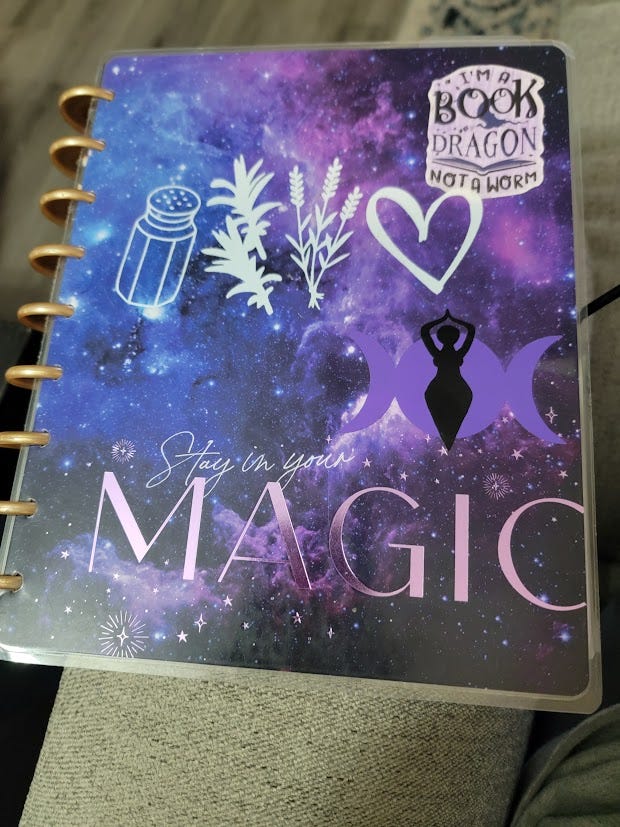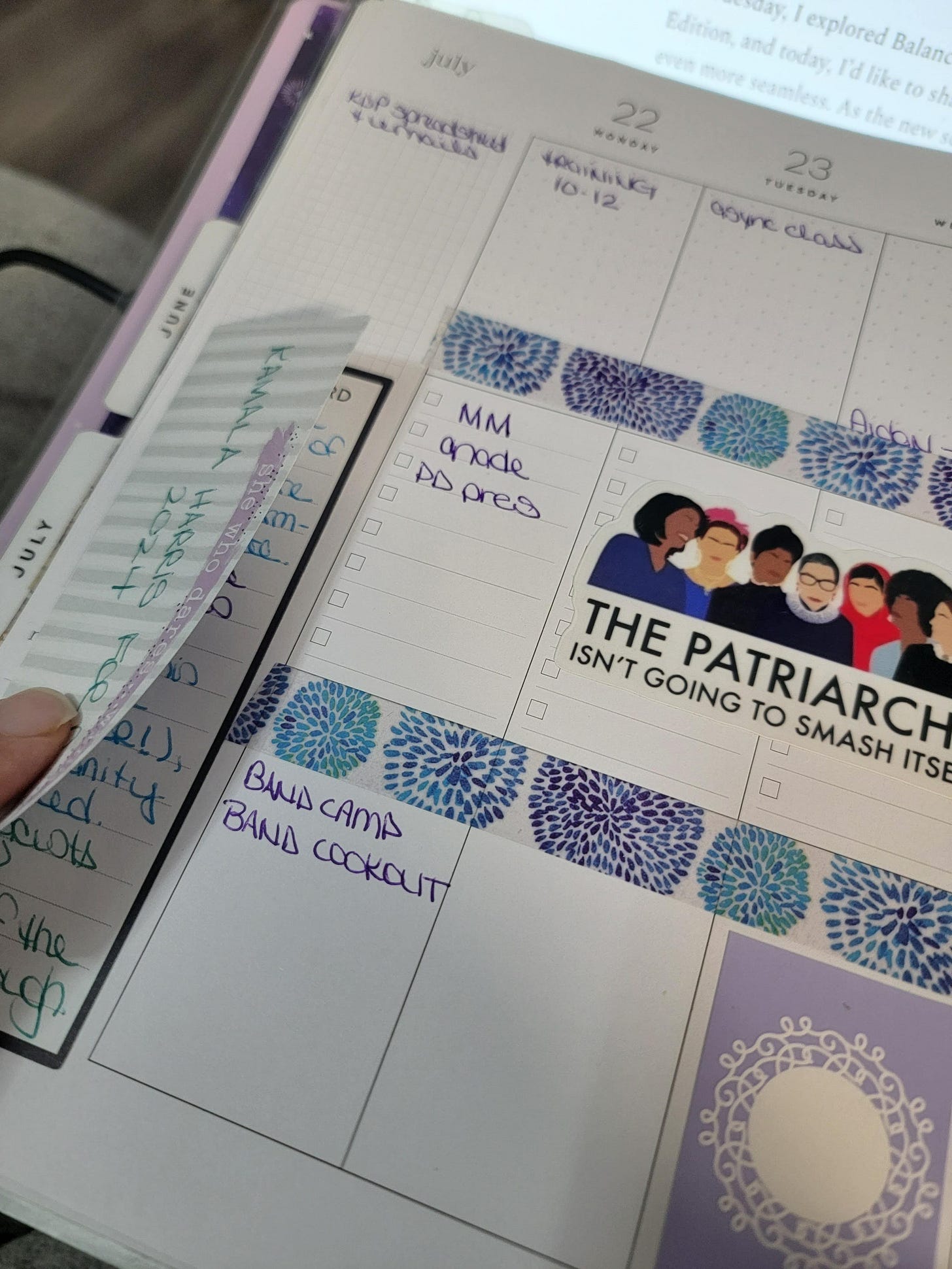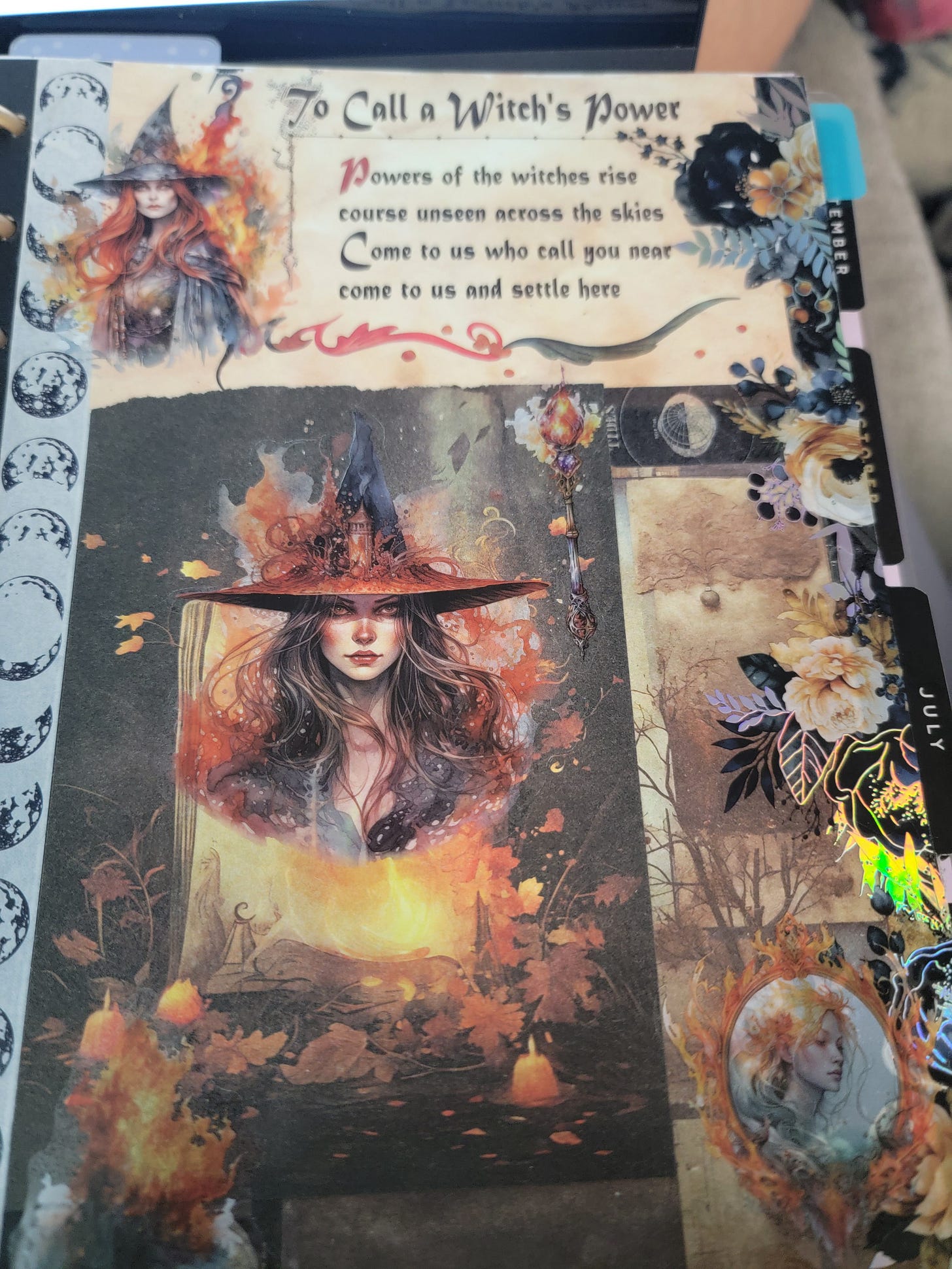On Tuesday, I explored Balancing Day Jobs with Witchy Life in the Back to School Edition, and today, I’d like to share how I use my paper planner to make that balance even more seamless. As the new school year approaches, setting up a planner that keeps me organized and helps track and manifest my magic becomes essential. Integrating a bit of witchy wisdom into daily planning can make a world of difference, so here's how to create a planner that blends practicality with a touch of enchantment.
1. Choose Your Planner
First things first, pick a planner that resonates with you. Look for one with ample space for daily entries, notes, and sections for your magical practices. Consider colors and designs that make you feel inspired and connected to your inner witch. If you're crafty, you might even want to decorate a plain planner with your own magical symbols and artwork.
Over the years, I’ve used many, many different planners (and even created many from scratch). The last two years, though, I’ve used a Happy Planner (Classic). I like the “magical” cover of the one I chose (it literally says, “Stay in your MAGIC” across the bottom) and the ability to take out and add pages. I carry only a semester at a time with me, so there’s plenty of room to add note pages for additional to-dos and meeting notes and even pages devoted to my witchy goals of the week or month. (That means, I set up my planner three times a year: in January for the spring semester, in June for the summer, and in August for the fall semester.)
Obviously, from the photo, you can see that I add stickers all over it, but I’ve used the same cover for two years, replacing one ring that I broke and buying or creating new inserts as needed.
2. Cleanse and Set Your Intentions
Before diving into a new planner, start by cleansing it to clear any lingering energies. You can do this by using sage, placing a cleansing crystal on it, or visualizing white light enveloping it. Once cleansed, take a moment to set your intentions for the school semester or year. What are your goals? What kind of energy do you want to attract? Write these intentions on the first page of your planner. You can also include affirmations and mantras to refer back to throughout the year.
To dedicate your planner to your goals, you might say or write: “I dedicate this planner to my growth, success, and well-being. May it help me stay organized, focused, and aligned with my intentions. Let it be a tool for manifesting my dreams and harnessing my magical potential. So it is.”
As I talked about in my Revisiting New Year’s Resolutions post, I write my Word Of The Year (or phrase, this year) in the front of my planner, on monthly page spreads, and in weeks when I need to remind myself of my focus.
3. Monthly Moon Phases
Keep track of the moon phases each month. The lunar cycle is a powerful guide for magical practices. Note the new moon for setting intentions, the waxing moon for growth, the full moon for manifestation, and the waning moon for release. Add these dates to your planner and plan rituals or meditations accordingly.
As I noted in my post on Paper Crafting, I like altering my planner a lot. Stickers are my best tool, and moon phase stickers are easily found (cheaply), so I go through the planner and add the ones I want to note the most by adding appropriate stickers.
4. Daily Gratitude and Reflection
Dedicate a small section of your daily entries to gratitude and reflection. Each day, write down something you're grateful for and a brief reflection on your day. This practice keeps you grounded and mindful, helping you stay connected to the present moment and your magical journey.
I use a grateful jar instead, so I don’t do daily gratitude in my planner, but I do note things of significance, both personally and historically so the planner serves as a “record” of my life. I track anything from my eldest dog’s cancer diagnosis and tumor growth to changing political events. I always try to note the good stuff too (like when my kids have a significant event or we just had fun doing something). Sometimes, I just jot it down, and sometimes I reflect in greater depth. I’m a pro at adding pages and hidden journaling pockets to my planner to have more writing space. The planner becomes a scrapbook of my life: part memoir.
(Here’s an example of a hidden journaling area.)
5. Spell Tracking and Ritual Planning
Use your planner to track spells and plan rituals. Note the materials you'll need, the steps involved, and the results. This not only keeps you organized but also helps you see patterns in your magical practice. You can also plan seasonal rituals and celebrations, marking the equinoxes, solstices, and other significant dates.
The Pink Moon Spell I posted, for instance, was just notes on a page in my planner until I typed it up for that post. I also note things like when I want to cook, make, bake certain foods for the appropriate season or pagan holiday celebration.
Or here, I did a full-page spread for part of my Litha ritual, a time when I stop to make sure I call back my power to me.
By housing my notes about my magic, my planner serves an additional purpose: part grimoire.
6. Magical To-Do Lists
Incorporate magical to-do lists into your planning. Alongside your everyday tasks, add items like “charge crystals,” “cleanse space,” or “practice divination.” This ensures you make time for your magical practices amidst your daily responsibilities. This is a great way to remind yourself not to get caught up in the whirlwind of the work grind and forget to live your life the way you want.
7. Tarot and Oracle Card Pulls
Consider pulling a tarot or oracle card (see my post about Tarot and Cultural Appropriate here) at the beginning of each week and writing down its message in your planner. Reflect on how this guidance can influence your week. This practice can provide insight and direction, aligning your mundane tasks with your spiritual path.
Tarot card stickers are also in abundance, cheap, so sometimes, I pull a tarot card sticker and put it in my planner for the week. I reflect about the card’s meaning and how it might enlighten my tasks (or emotions) for the week.
I always do a New Year’s tarot reading spread in my planner. Here, in this photo, you can see I created an oracle spread that represents my WOTY (happy, healthy, whole), and on the left, I pulled a card to guide my year: The Chariot. This two-page spread stays at the front of my planner, even when I take out the early months of the year to make space for the later ones (currently, I have June - December in, but soon, I’ll remove June and July to make more room for the semester that runs August - December).
8. Self-Care Scheduling
Remember to schedule self-care activities. Whether it’s a long bath, a walk in nature, or a night of stargazing, make sure you’re taking time to recharge. Self-care is an essential part of maintaining your magical energy and overall well-being.
9. Connect with Nature and Gardening
Incorporate nature into your planner to stay in tune with the natural world. Note the seasonal changes, local flora and fauna, and any nature-based activities you want to engage in. Additionally, dedicate a section for gardening notes. Track planting schedules, growth progress, and any magical practices you incorporate into your gardening routine, like moon phase planting or herbal enchantments. Observing and connecting with nature enhances your magical practice and keeps you grounded.
I like to note when I plant things, when I should begin to look for harvests, and treatments given (calcium supplements for the soil, for example), and notes when I try to grow new things. I also note periods of “weird” weather than might affect the garden (or my mood!).
10. Mundane Scheduling for the New School Year
While it's essential to weave magic into your planner, don't forget to cover the practical, everyday aspects of your life. Dedicate sections for class schedules, work shifts, office hours, assignment deadlines, major tests or work activities, and the kids’ extracurricular activities and schedules (for me, it’s essential to include the drop / off pick up schedule, since my husband and I split that). You might color-code these entries to distinguish between different areas of your life, making it easier to see your commitments at a glance. By staying organized with your own tasks and your children's activities, you'll create a stable foundation that supports your magical practices and helps you achieve a balanced, fulfilling school year.
Review & Reflect
At the end of each month, review your planner. Reflect on what worked, what didn’t, and how you can adjust your practices for the upcoming month. This regular review helps you stay aligned with your goals and intentions, allowing you to grow and adapt throughout the school year. Use this to help you plan the next week. I “schedule” time to plan each week out, since I have to add new meetings and activities regularly. I take at least half an hour each Monday morning to re-plan out the upcoming week, figure out whose in charge of food when, what adjustments to our regular schedule need made, and what my overall goals for the week are. Planning is not a one-and-done thing for me; it’s an ongoing process that makes my life easier and more intentional.
By integrating these practices into your planner, you create a unique tool that serves as both a practical organizer and a magical grimoire. This planner will help you navigate the school year / new semester with intention and balance, capturing both the mundane and the magical aspects of your journey. As you fill its pages with your daily tasks, magical notes, and personal reflections, it becomes a treasured memoir of your life. Embrace the process, and let your planner be a source of inspiration and empowerment throughout the year. Here's to a school year filled with productivity, growth, and a touch of enchantment!







